Inside the homeless tent city taking over Sydney’s iconic Martin Place
GROWING every day, a sea of tents is taking over one of Sydney’s most iconic streets. Residents are determined to stay.
LOCATED on one of Sydney’s most prestigious streets is a very exclusive place to stay.
There’s a hot breakfast to start the day and chef cooked meals in the evening. The dining is alfresco, the security 24/7 and the view, of some of Sydney’s most historic buildings, is sublime.
But this is no Intercontinental or Shangri-La hotel; a room won’t cost a week’s wages. In fact it won’t cost anything at all.
That’s because this is Sydney’s tent city in the iconic Martin Place, directly opposite the Reserve Bank.
And it’s part of a furious blame game between the state government and City of Sydney council with the latter saying the camp is the “inevitable consequence of housing affordability in our city”.
Indeed, scrawled on one of the tents are the words, “For many this is what affordable Sydney housing look like.”
At least 35 tents stretch from one side of the street to the other; the organisers estimate two more are put up every day.
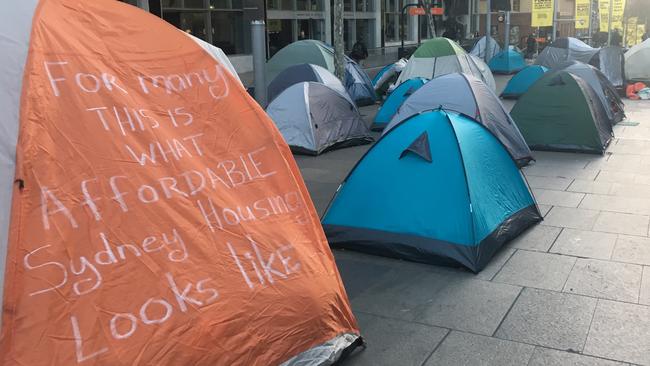
Sharply dressed commuters, streaming from the station to the street’s many skyscrapers, dart between the tents like pin balls in an arcade machine.
Nigel Blakemore’s tent stands in the middle, shining silver beneath the street lights.
“I was the kind of person who would walk past, be annoyed, and ring the council and say ‘when will you move these bloody people on?’” Mr Blakemore tells news.com.au.
“I was kicking goals, I was living a life.
“It wasn’t until I fell into the abyss and became homeless that I reflected on what kind of person I was”.
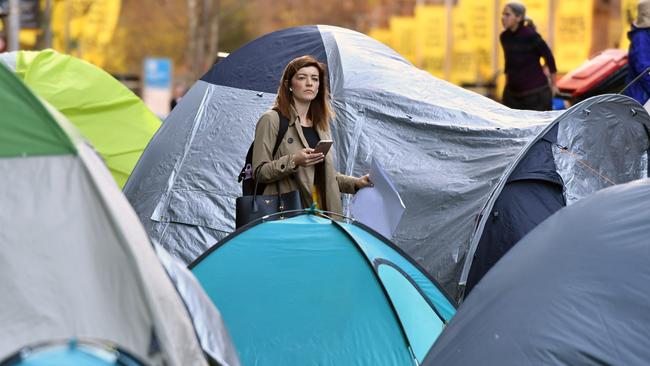
News.com.au talked to people living in the tents who used to be retail managers and telephone sales staff.
Mr Blakemore used to be a high flyer in the media industry living in Hong Kong with his wife and son.
“I’d been there for 14 years and then I went through a very acrimonious divorce. I had immigration issues and when I came back my mum died — my life just fell apart.
“I didn’t have suicidal tendencies but I couldn’t find a way over the mountain before me.”
He was found a place on one of Sydney’s most notorious housing projects but it was so dangerous he feared leaving his room.
“I’m happier here [at the camp].”
Mr Blakemore said the camp is a “community of equals”. But he acknowledges that some are more equal than others.
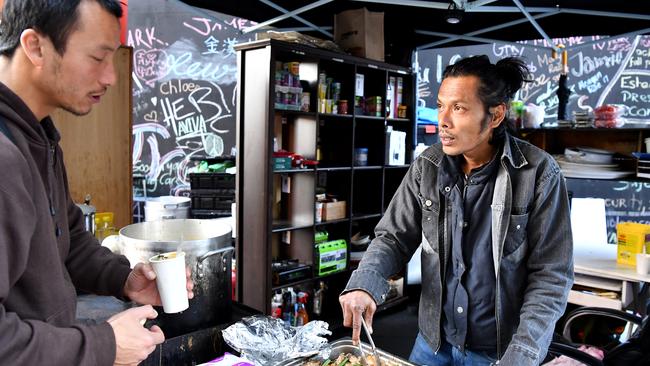
“There’s no hierarchy but there is a hierarchy of respect.”
He’s second in charge of the camp, after chief organiser Lanz Priestley, dubbed the “mayor of Martin Place”.
“Lanz has the respect of everyone and that filters down,” he says.
Mr Blakemore estimates that at any one time 45 people are sleeping at the camp with another 100 dropping in for food each day.
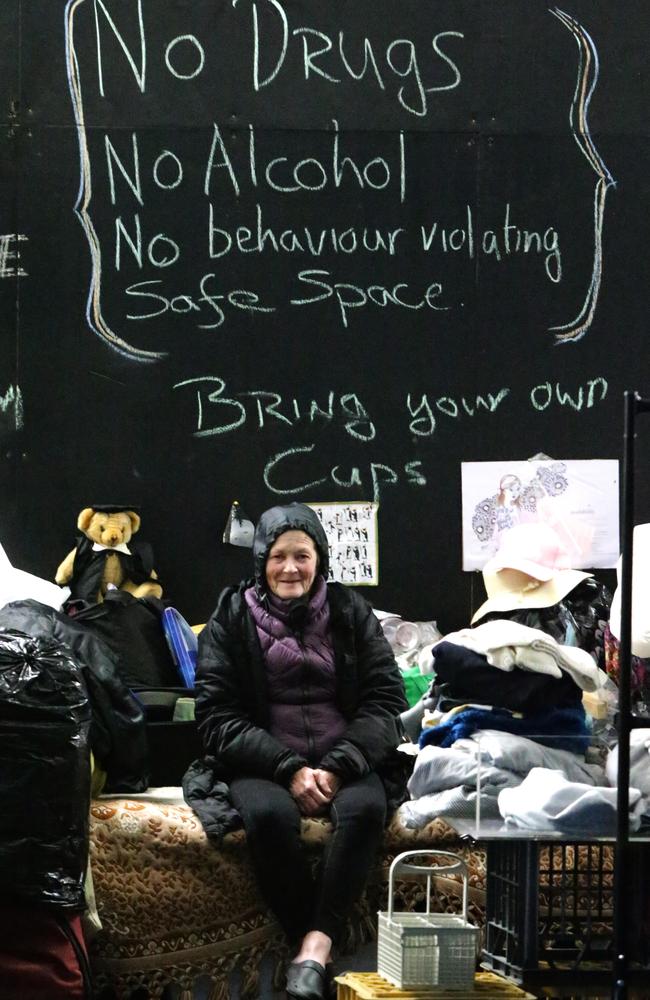
It was just over a month ago that the City of Sydney moved away much of the previous camp sited in almost exactly the same spot. It was deemed a “public nuisance” and a fire risk.
This time the organisers are taking no risks. Unlike previously, the camp is now spotless.
“We’ve had the fire brigade tell us there must be a certain distance between tents. If the council thinks it’s a fire hazard they can boot us out but if we’ve adhered to all the rules that eradicates that worry”.
Signs around the camp say drugs and drink won’t be tolerated. Another attempt to make the tent city more tolerable.
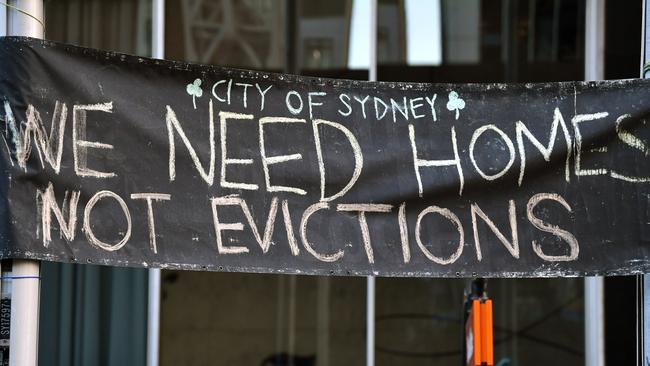
A woman in a sleeping bag roams the camp. “Last night we had to pack up her tent because she’s been drinking and causing some problems,” says Blakemore. “If she curbs her behaviour she can stay.”
Someone stays up all night to serve coffee and keep the camp in order.
“It does have its moments,” he admits. “But we try and jump on them pretty quick. Even groups of AB demographic businessmen have their moments too.”
Blake Metcalfe is in temporary accommodation but volunteers at the camp.
“It’s like going to the pub. If you’re drunk, you get kicked out.”
The tents are simply laid out. A single mattress, often propped up on milk crates, and some bedding.
One of the features of the camp is that many of the tents belong to the camp, not individuals.
As residents leave, they clean up their accommodation ready for the next person.
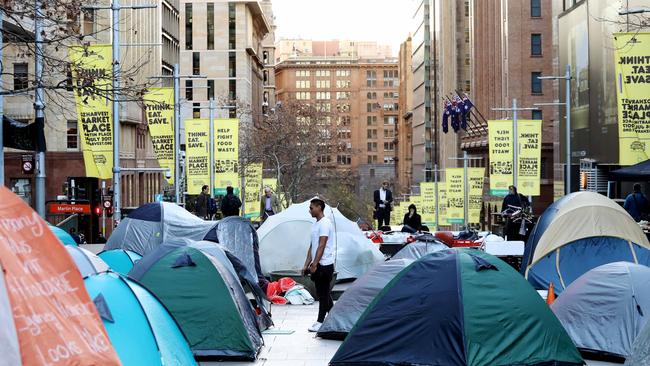
Pru Goward, the NSW Minister for Family and Community Services said housing staff had attended Martin Place 40 times to offer services and accommodation and 60 people who were sleeping rough are now in permanent housing.
“Family and Community Services has worked intensively to engage with those sleeping rough in Martin Place. [They] will continue to work with anyone willing to engage to find a long-term housing solution.”
“It’s disappointing that [Sydney Lord Mayor] Clover Moore has not done her job, while we continue to do ours,” she told news.com.au.
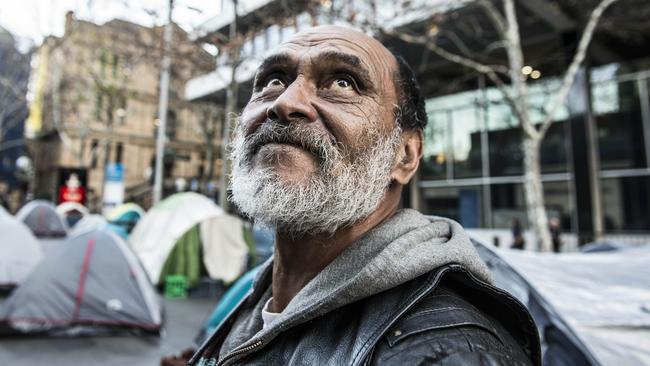
That’s not how Lord Mayor Moore sees it. She told news.com.au she was “deeply concerned” about the rough sleepers in her patch but the state government, not the council, was responsible for providing affordable housing and supporting the homeless. Nevertheless the city was “doing more than any other council in the country” to house people.
“The fact is, you can’t solve homelessness without housing — what we urgently need is more affordable housing and we urgently need the NSW Government to step up and do their bit.
“It’s not illegal for people to be homeless — for some people it’s a virtually inevitable consequence of the housing affordability crisis in our city.”
In February, a homeless camp at Melbourne’s Flinders St station was broken up.
But Ms Moore denied the city had removed Martin Place’s previous camp, rather, they had to move those parts of the camp to ensure Martin Place was accessible.
Like many at Martin Place, Mr Metcalfe’s journey began with a relationship ending and demons taking over.
“In two years, I spent $200,000 on alcohol and gambling. I had nothing and then I got two high range drink driving offences.”
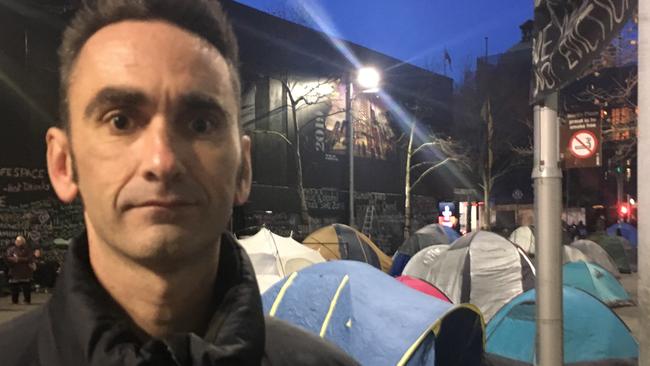
He had worked as a sales rep at a spare parts company.
“I’d never been to jail before. When I got out of Silverwater [jail] I walked past here with a backpack.
“I didn’t have anywhere to go, I was bawling my eyes out and I didn’t want to sleep on a train station. These guys pretty much saved my life.”
He was quickly found accommodation off the streets but now comes down at 5.30am to cook breakfast at the camp’s kitchen.
The kitchen is the social centre of the camp. As the sun sets, boxes of pizzas and sandwiches arrive, donated by local cafes. A chicken schnitzel on Turkish would have cost at least $10 an hour ago — now it’s free at the camp.
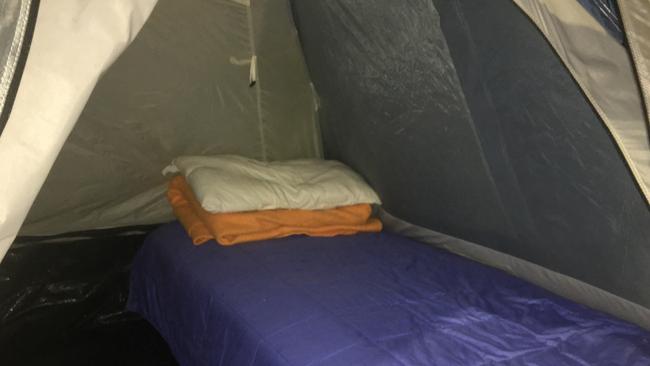
The location of the tents is not by accident. The organisers want people to be reminded that Sydney has a homeless problems.
Figures from the City of Sydney found around 900 people were homeless in the council’s boundaries in February 2017, half of those on the street.
“We’re a group of homeless people who have banded together to make life safer and have more dignity than we would have if we were by ourselves,” said Mr Blakemore.
He denies the camp is a nuisance. Far from it, he thinks it’s so well run it could be replicated elsewhere.

“Finally, they’re starting to realise they can just sweep us away. Rather they need to see how it works and how can we benchmark and even franchise it.”
It would be “politically brave” to move the camp on again, he said. There will always be people looking for somewhere safe to bed down.
“There’s no finale. This is an example of the community we can build.”
One of the camp’s residents is also a violinist. As the street lights flicker on, he begins to play among the tents.
Commuters rush past him but the people living in Martin Place’s tents linger and listen.




